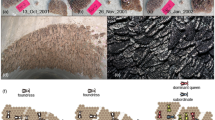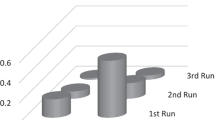Summary
Starting colonies of the desert seed-harvester antMessor pergandei are clumped in the field and face severe intraspecific competition through brood raiding. Single foundress laboratory colonies ofM. pergandei are more likely to succeed at brood raiding with conspecific colonies if they are given additional workers and mature pupae several days prior to brood raiding. Per foundress fecundity remains constant across laboratory starting colonies established with 1, 3 and 5 foundresses. These results suggest that the selective advantage of cooperative colony foundation (pleometrosis) in this and similar species may derive directly from the ability of multiple foundresses to produce a larger brood raiding force.
Similar content being viewed by others
References
Abrams, J. and G. C. Eickwort, 1980. Biology of the communal sweat beeAgapostemon virescens (Hymenoptera: Halictidae) in New York State.Search (Cornell Univ. Agr. Exp. Sta) 1:1–20.
Abrams, J. and G. C. Eickwort, 1981. Nest switching and guarding by the communal sweat beeAgapostemon virescens (Hymenoptera; Halictidae).Ins. Soc. 28:105–116.
Bartz, S. H. and B. Hölldobler, 1982. Colony founding inMyrmecocystus mimicus Wheeler (Hymenoptera: Formicidae) and the evolution of foundress associations.Behav. Ecol. Sociobiol. 10:137–147.
Bolton, B., 1982. Afrotropical species of the myrmecine ant generaCardiocondyla, Leptothorax, Melissotcersus, Messor andCataulacus (Formicidae).Bull. Brit. Mus. (Natural History) (Entomology) 45:307–370.
Byron, P. A., E. R. Byron and R. A. Bernstein, 1980. Evidence of competition between two species of desert ants.Ins. Soc. 27:351–360.
Carlin, N. F., 1988. The gyne who would be queen: dominance in the antIridomyrmex purpureus. In:Interindividual Behavioral Variability in Social Insects (R. L. Jeanne, Ed.), Westview Press, publ., Boulder, Col., pp. 147–177.
Gamboa, G. J., 1978. Intraspecific defense: advantage of social cooperation among paper wasp foundresses.Science 199:1463–1465.
Gibo, D. L., 1978. The selective advantage of foundress associations inPolistes fuscatus (Hymenoptera: Vespidae): a field study of the effects of predation on productivity.Can. Entomol. 110:519–540.
Hagen, R. H., D. R. Smith and S. W. Rissing, 1988. Genetic relatedness among co-foundresses of two desert ants,Veromessor pergandei andAcromyrmex versicolor (Hymenoptera, Formicidae).Psyche 95:191–202.
Hollander, M. and D. A. Woolf, 1973.Nonparametric Statistical Methods. John Wiley and Sons, publ., New York, XVIII + 503.
Hölldobler, B. and N. F. Carlin, 1985. Colony founding, queen dominance and oligogyny in the Australian meat antIridomyrmex purpureus.Behav. Ecol. Sociobiol 18:45–48.
Hölldobler, B. and E. O. Wilson, 1977. The number of queens: an important trait in ant evolution.Naturwissen. 64:8–15.
Itô, Y., 1985. Colony development and social structure in a subtropical paper wasp,Ropalidia fasciata (F.) (Hymenoptera: Vespidae).Res. Popul. Ecol. 27:333–349.
Itô, Y., 1987. Role of pleometrosis in the evolution of eusociality in wasps. In:Animal Societies: Theories and Facts (Y. Itô, J. L. Brown and J. Kikkawa, Eds.), Japan Sci. Soc. Press, publ., Tokyo, pp. 17–34.
Lin, N. and C. D. Michener, 1972. Evolution of sociality in insects.Q. Rev. Biol. 47:131–159.
Markin, G. P., H. L. Collins and J. H. Dillier, 1972. Colony founding by queens of the red imported fire ant,Solenopsis invicta.Ann. Entomol. Soc. Amer. 65:1053–1058.
Michener, C. D., 1964. Reproductive efficiency in relation to colony size in hymenopterous societies.Ins. Soc. 11:317–341.
Michener, C. D., 1974.The social behavior of the bees. Belknap Press of the Harvard University Press, publ., Cambridge, Mass., XII + 404 pp.
Mintzer, A. C., 1987. Primary polygyny in the antAtta texana: number and weight of females and colony foundation success in the laboratory.Ins. Soc. 34:108–117.
Oster, G. F. and E. O. Wilson, 1978.Caste and ecology in the social insects. Princeton University Press, publ., Princeton, New Jersey, XV + 352 pp.
Pollock, G. B. and S. W. Rissing, 1985. Mating season and colony foundation of the seed-harvester ant,Veromessor pergandei.Psyche 92:125–134.
Pollock, G. B. and S. W. Rissing, 1989. Interspecific brood raiding, territoriality, and slavery in ants.Amer. Nat. 133:61–70.
Rissing, S. W. and G. B. Pollock, 1986. Social interaction among pleometrotic queens ofVeromessor pergandei (Hymenoptera: Formicidae) during colony foundation.Anim. Behav. 34:226–233.
Rissing, S. W. and G. B. Pollock, 1987. Queen aggression, pleometrotic advantage and brood raiding in the antVeromessor pergandei (Hymenoptera: Formicidae).Anim. Behav. 35:975–981.
Rissing, S. W. and G. B. Pollock, 1988. Pleometrosis and polygyny in ants. In:Interindividual Behavioral Variability in Social Insects, (R. L. Jeanne, Ed.), Westview Press, publ., Boulder, Col., pp. 179–222.
Rissing, S. W. and G. B. Pollock, 1989. Behavioral ecology and community organization of desert seed-harvester ants.J. Arid Environs 17:167–173.
Ryti, R. T. and T. J. Case, 1984. Spatial patterns and diet overlap between colonies of three desert ant species.Oecologia 62:401–404.
Strassmann, J. E., 1983. Nest fidelity and group size among foundresses ofPolistes annularis (Hymenoptera: Vespidae).J. Kans. Entomol. Soc. 56:621–634.
Taki, A., 1976. Colony founding ofMessor aciculatum (Fr. Smith) (Hymenoptera: Formicidae) by single and grouped queens.Physiol. Ecol. Japan 17:503–512.
Tschinkel, W. R., 1987. The fire ant,Solenopsis invicta, as a succesful “weed”. In:Chemistry and biology of social insects, (J. Eder and H. Rembold, Eds.), Verlag J. Peperny, publ., Munich, pp. 585–588.
Tschinkel, W. R. and D. F. Howard, 1983. Colony founding by pleometrosis in the fire ant,Solenopsis invicta.Behav. Ecol. Sociobiol. 12:103–113.
Waloff, N., 1957. The effect of the number of queens of the antLasius flavus (Fab.) (Hym., Formicidae) on their survival and on the rate of development of the first brood.Ins. Soc. 4:391–408.
Went, F. W., G. C. Wheeler and J. Wheeler, 1972. Feeding and digestion in some ants (Veromessor andManica).Bioscience 22:82–88.
West Eberhard, M. J., 1969. The social biology of polistine wasps.Misc. Publs. Univ. Mich. (Mus. Zool.) 140:1–101.
West Eberhard, M. J., 1979. Sexual selection, social competition, and evolution.Proc. Amer. Phil. Soc. I, II, III:222–234.
West Eberhard, M. J., 1983. Sexual selection, social competition, and speciation.Q. Rev.Biol. 53:155–183.
Wheeler, J. and S. W. Rissing, 1975. Natural history ofVeromessor pergandei. II. Behavior.Pan-Pac. Entomol. 51:303–314.
Author information
Authors and Affiliations
Rights and permissions
About this article
Cite this article
Rissing, S.W., Pollock, G.B. An experimental analysis of pleometrotic advantage in the desert seed-harvester antMessor pergandei (Hymenoptera; Formicidae). Ins. Soc 38, 205–211 (1991). https://doi.org/10.1007/BF01240970
Received:
Accepted:
Issue Date:
DOI: https://doi.org/10.1007/BF01240970




